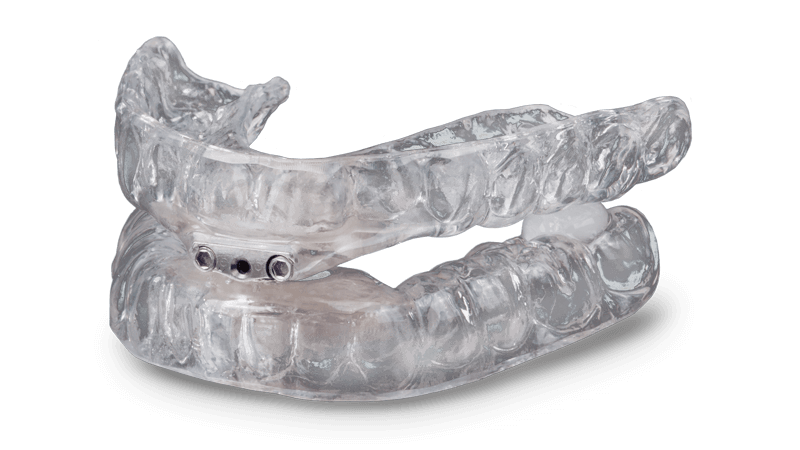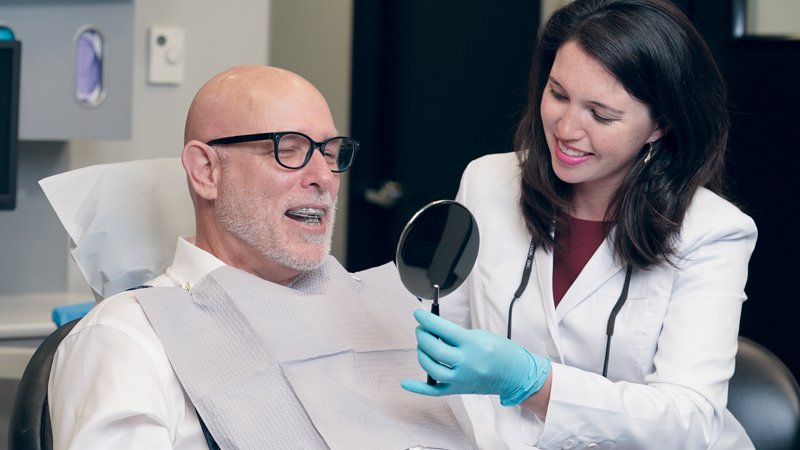- PDAC (Pricing, Data Analysis and Coding) contractor-verified for Medicare reimbursement: Code E0486
- Comfortable for all-night wear
- Custom-fabricated for precise fit

TAP® 3 TL
*Price is per appliance and does not include shipping or applicable taxes.
Helping patients get the rest they need, the TAP® 3 TL appliance holds the lower jaw in a forward position during sleep to reduce snoring and improve breathing.
Your Solution for Snoring and Sleep Apnea
Helping patients who suffer from sleep-disordered breathing, the TAP 3 TL is part of the TAP family of appliances for the treatment of snoring and obstructive sleep apnea (OSA). Based on the same principle as cardiopulmonary resuscitation (CPR), the TAP (Thornton Adjustable Positioner) was designed to keep the airway open to allow for air to pass. A constricted or collapsed airway causes snoring and OSA. The TAP device holds the lower jaw in a forward position, maintaining a clear airway to reduce snoring and improve breathing.
Fitting comfortably, the TAP 3 TL is designed to provide room for the tongue and allow the lips to close. An adjustment key enables the patient to adjust the protrusion of the lower jaw while wearing the device until a comfortable and effective position is achieved.
TAP is a registered trademark of Airway Management Inc.

Patient Satisfaction
Oral appliance therapy (OAT) is very effective in treating patients with sleep-disordered breathing, with a compliance rate shown to be as high as 90% over a 2.5-year period.1
OAT is associated with greater patient satisfaction than nasal continuous positive airway pressure (CPAP) therapy.2
In a randomized crossover trial comparing OAT to CPAP in patients with obstructive sleep apnea, about 81% preferred OAT.3

Improved Health
Among patients with obstructive sleep apnea, both continuous positive airway pressure (CPAP) and mandibular advancement devices (MADs) were associated with reductions in blood pressure. Network meta-analysis did not identify a statistically significant difference between the blood pressure outcomes associated with these therapies.4
A mandibular advancement device for obstructive sleep apnea reduces nocturnal blood pressure in women.5

Prevalence of Snoring and Obstructive Sleep Apnea
About half of the U.S. adult population experiences some form of sleep-disordered breathing.

Dental sleep medicine has been an advantageous component of my practice ... When you give a patient back a smile, it’s an important and rewarding part of the profession. But when you shift the focus to sleep and airway health, you give patients back their life.
Indications
The TAP 3 TL is intended to reduce or alleviate nighttime snoring and sleep-related breathing disorders, including obstructive sleep apnea (OSA).
Material Composition
Thermoformed triple laminate and cobalt-chrome alloy hardware
In-Lab Working Times
5 days
Available Colors
Clear
Pricing
|
TAP® 3 TL(PDAC-approved) (buy 1)
|
$493.001 |
|
Glidewell Clinical Twinpak(buy 2)2
|
$956.001 |
Digital file storage is available for this product. See Scan & Save Services.
Glidewell Clinical Twinpak is valid for two appliances for the same case.
Pricing is subject to change and does not include shipping or applicable taxes.
Policies & Warranty
NO-FAULT REMAKE POLICY: Glidewell is pleased to process all remakes or adjustments at no additional charge if requested within the warranty period and accompanied by the return of the original appliance.
LIMITED WARRANTY/LIMITATION OF LIABILITY. Glidewell (“the lab”) warrants that all dental devices (a “device”) are made according to your specification and approval in the belief that the device will be useful and MAKES NO OTHER WARRANTIES INCLUDING, BUT NOT LIMITED TO, ANY IMPLIED WARRANTY OF MERCHANTABILITY OR FITNESS FOR A PARTICULAR PURPOSE. Subject to the return of a device that is placed and then fails, the lab will repair or replace the device without charge for the cost of materials and workmanship or refund the original price paid, at the lab’s option, for up to 2 years for the TAP 3 TL appliance.
Procedures
References
- ^ Yoshida K. Effects of a mandibular advancement device for the treatment of sleep apnea syndrome and snoring on respiratory function and sleep quality. Cranio. 2000 Apr;18(2):98-105.
- ^ Ferguson KA, Ono T, Lowe AA, Keenan SP, Fleetham JA. A randomized crossover study of an oral appliance vs. nasal-continuous positive airway pressure in the treatment of mild-moderate obstructive sleep apnea. Chest. 1996 May;109(5):1269-75.
- ^ Tan YK, L’Estrange PR, Luo YM, Smith C, Grant HR, Simonds AK, Spiro SG, Battagel JM. Mandibular advancement splints and continuous positive airway pressure in patients with obstructive sleep apnoea: a randomized cross-over trial. Eur J Orthod. 2002 Jun;24(3):239-49.
- ^ Bratton DJ, Gaisl T, Wons AM, Kohler M. CPAP vs. mandibular advancement devices and blood pressure in patients with obstructive sleep apnea: a systematic review and meta-analysis. JAMA. 2015 Dec 1;314(21):2280-93.
- ^ Rietz H, Franklin KA, Carlberg B, Sahlin C, Marklund M. Nocturnal blood pressure is reduced by a mandibular advancement device for sleep apnea in women: findings from secondary analyses of a randomized trial. J Am Heart Assoc. 2018 Jun 21;7(13).


